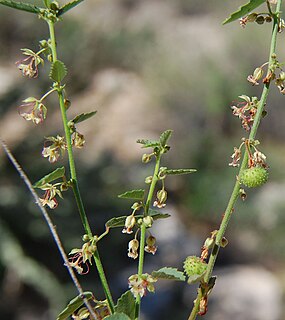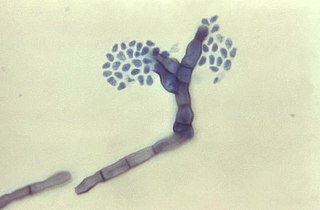Related Research Articles

The substantia nigra (SN) is a basal ganglia structure located in the midbrain that plays an important role in reward and movement. Substantia nigra is Latin for "black substance", reflecting the fact that parts of the substantia nigra appear darker than neighboring areas due to high levels of neuromelanin in dopaminergic neurons. Parkinson's disease is characterized by the loss of dopaminergic neurons in the substantia nigra pars compacta.

Pterobranchia is a class of small worm-shaped animals. They belong to the Hemichordata, and live in secreted tubes on the ocean floor. Pterobranchia feed by filtering plankton out of the water with the help of cilia attached to tentacles. There are about 25 known living pterobranch species in three genera, which are Rhabdopleura, Cephalodiscus, and Atubaria. On the other hand, there are several hundred extinct genera, some of which date from the Cambrian Period.
The pars compacta (SNpc) is a portion of the substantia nigra, located in the midbrain. It is formed by dopaminergic neurons and located medial to the pars reticulata. Parkinson's disease is characterized by the death of dopaminergic neurons in this region.
The Cerro Pando Salamander is a species of salamander in the family Plethodontidae. It is found in Costa Rica and Panama. Its natural habitat is subtropical or tropical moist montane forests. It is threatened by habitat loss.

Leptoxis compacta, the oblong rocksnail, is a species of freshwater snail with an operculum, an aquatic gastropod mollusk in the family Pleuroceridae.
Partula compacta was a species of air-breathing tropical land snail, a terrestrial pulmonate gastropod mollusk in the family Partulidae. This species was endemic to French Polynesia. It is now extinct.

Victaphanta compacta, common name the Otway black snail, is a species of carnivorous air-breathing land snail, a terrestrial pulmonate gastropod mollusks in the family Rhytididae. The Otway Black Snail Victaphanta compacta is only found in cool temperate rainforests in the Otway Ranges, Victoria, Australia. It is one of four species of the carnivorous land snails in the genus Victaphanta and is endemic to the Otway Ranges.

Onychoteuthis compacta is a species of squid in the family Onychoteuthidae, known to occur in Hawaiian waters. as well as in other areas of the Central Pacific and western north-central Atlantic, it probably has a circumglobar distribution. The species is known to have a mantle length of at least 122 mm for females and 127 mm for males. Each tentacle has 22 club hooks, measuring approximately 30 mm in mature specimens.

Ayenia compacta is a species of shrub in the mallow family known by the common name California ayenia.

Liatris compacta, sometimes called Arkansas gayfeather, is a herbaceous plant species in the family Asteraceae and genus Liatris. It is native to the Ouachitas of west-central Arkansas and eastern Oklahoma in the central United States, where it is found growing in habitats such as rocky ridges, bluffs, hillsides, weathered sandstone, and open woods. It blooms in June to September and may start blooming as early as May, it has purple flowers grouped into heads. It was known as a variety of Liatris squarrosa as Liatris squarrosa var. compacta until relatively recently.
C. compacta may refer to:
P. compacta may refer to:
L. compacta may refer to:
A. compacta may refer to:

Hemithrinax compacta is a species of palm that is endemic to Cuba.

Fonsecaea compacta is a saprophytic fungal species found in the family Herpotrichiellaceae. It is a rare etiological agent of chromoblastomycosis, with low rates of correspondence observed from reports. The main active components of F. compacta are glycolipids, yet very little is known about its composition. F. compacta is widely regarded as a dysplastic variety of Fonsecaea pedrosoi, its morphological precursor. The genus Fonsecaea presently contains two species, F. pedrosoi and F. compacta. Over 100 strains of F. pedrosoi have been isolated but only two of F. compacta.

Cuscuta compacta, the compact dodder, is a parasitic plant that specializes on woody plants. This species is distributed across the Eastern and Midwestern USA, Eastern Canada, and Mexico.
Coptosia compacta is a species of beetle in the family Cerambycidae. It was described by Édouard Ménétries in 1832, originally under the genus Saperda. It is known from Israel, Iran, Syria, Armenia, Jordan, and Turkey.
Graciella compacta is a species of beetle in the family Cerambycidae. It was described by Karl Jordan in 1894.
Ponerorchis compacta is a species of flowering plant in the family Orchidaceae, native to south-central China.
References
- ↑ Biolib.cz - Gibbestoloides compacta. Retrieved on 8 September 2014.